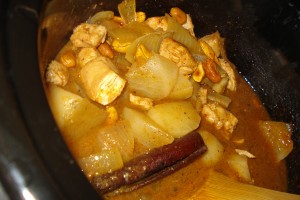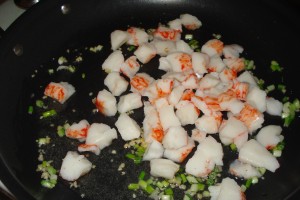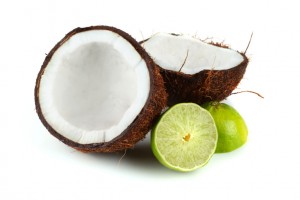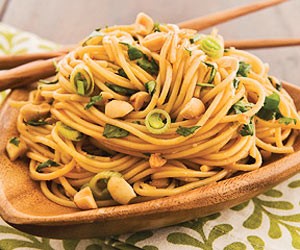I work as a university instructor, which means I’m a contract employee: my workload varies from term to term, and so, therefore, does my paycheck. Last term I was teaching four classes, which meant we had no money problems, but it also meant that I was constantly stressed out and we ate take-out every night we didn’t go to a restaurant for dinner – hardly ideal. This term I’m teaching three classes, which means a few money problems, but significantly better mental health, homecooked meals, and a clean house. I think the latter is preferable to the former overall.

The Initial Food Processing ... Process
At the start of the year, for the sake of thrift and with an eye towards improved health, I vowed that we would eat in at least five nights per week. Once a week I gin my will power up to go to the grocery store and buy really healthy stuff – that way, later in the week, when I definitely don’t have any will power and would totally eat Doritos for dinner, that’s just not an option, ‘cause the food budget’s already been spent on vegetables. So far, we’ve enjoyed a lot of enforced, not-necessarily-wholly-voluntary success in the Thrift and Health categories.
Here’s the trouble, though: besides just getting sick and tired of staying in (which so far there’s no solution for), I’m getting sick and tired of eating the stuff I know how to make. Now, don’t get me wrong: I’m actually a pretty good cook, and with the exception of my precious canned tomatoes, it’s all basically from scratch, mostly because 1) processed food is gross, and 2) it’s also more expensive per ounce usually – seriously, figure out the cost-per of a big pot of homemade soup vs. a can of soup. (Of course, homecooking is a luxury for people who have time, and I realize that; but thanks to my reduced workload this term, I’m blessed with the time to cook.) But what I’m used to cooking is basically American/European stuff, like stews and shepherd’s pie and so forth, and Italian food, like lasagna and pasta sauces and cacciatore. Which is all tasty, but … it’s not curry. I LOVE curry. Indian curry and Thai curry. Love. LOVE! But I don’t really know how to make it, and now, I can’t afford to go out for it all that often.
Sarah faced a similar problem, and solved it by learning to make curries on her own. This seemed a wise course, and unlike baking, cooking doesn’t intimidate me – as I said, it’s something I generally regard myself as being pretty good at. So I figured hell, I’ll just follow Sarah’s lead.

The Sauce Begins to Simmer
About a month ago, Sarah invited me over (along with Ted and Roger to taste test) for a night of Thai curries. She got a big book o’ Thai cooking out of the library and proceeded to, with my interpretive assistance, produce three no-paste Thai curries. (The pastelessness was a matter of working-woman efficiency: Sarah doesn’t have time to waste after a full day of professional dancing!) All three of the curries turned out really good! Not quite Pusadee’s Garden-grade, but very tasty. You can see Sarah’s results in this blog:
https://arwz.com/ssblog/2012/01/15/the-great-no-paste-thai-curry-experiment
So, having actually been there for the preparation of these curries, I thought, surely, working off of Sarah’s recipes, I could recreate one of them on my own. So two weeks ago, I set about to make my own …
“SARAH’S NO-PASTE GREEN CURRY
1 or 2 tablespoons vegetable oil
1 onion, chopped or diced
2 teaspoons minced garlic
1 tablespoon ground ginger (or more to taste)
2 green chilies, diced
1/4 teaspoon ground coriander seed
1/4 teaspoon cumin
1 teaspoon ground galangal
zest of 1/2 lemon peel, shredded finely
zest of one lime peel, shredded finely
1/2 cup fresh cilantro leaves, chopped
1/4 to 1/3 cup fresh basil leaves, chopped
1 tablespoon brown sugar
several dashes of fish sauce
1 (13-15 oz) can coconut milk
your choice of meat cubed, mixed vegetables or other protein
Sauté onion, garlic, ginger and chilies in vegetable oil for a few minutes. Add coriander, cumin, galangal, lemon zest, lime zest, cilantro and basil. Stir in brown sugar, fish sauce and coconut milk. At this point, depending on how finely you chopped the fresh herbs and chilies, you may want to process this sauce to a smoother consistency. I am a whole-hearted devotee of the immersion blender, as it will accomplish most such tasks in the kitchen without the necessity of dirtying the food processor bowl in addition to the cooking pot. If, however, you are one of the unfortunate class of Americans who do not own an immersion blender, you can always just transfer your sauce to a food processor. If you prefer to be proactive about it, you can take all the ingredients up to and including the coconut milk, combine them in your food processor, and then heat in the saucepan.
Once sauce is desired smoothness, add the meat, if using. If using a combination of meat and vegetables, like we did, the meat should be added first, cooked until tender, and then vegetables should be added and they can simmer together until the vegetables are done. I prefer curry meat to be so tender it easily falls apart under my fork, so there is no such thing for me as meat that is too well stewed.”

You Go to War with the Vegetables You Have
I followed the recipe more or less exactly, except that I used a teaspoon of dried lemongrass instead of the lemon rind. And because I don’t have an immersion blender, I had to sauté, then transfer to my food processor, then transfer back for further simmering, which was perilous and kind of a pain in the ass.
The final result was lackluster at best. I mean, it wasn’t BAD, it just wasn’t … good.
But I was determined to keep at it, and vowed to try again. Mark’s Made With Love Mondays gave me the impetus to attack the problem this week.
To begin with, I adjusted my technique to compensate for my lack of an immersion blender; rather than once again undertake the perilous hot-liquid double-transfer maneuver, I started by pureeing in my food processor:
1 chopped onion
4 large crushed garlic cloves
2 chopped jalapeno peppers, seeded and deveined
a large handful of fresh cilantro (probably about 1 cup)
about 1/3 of a cup of fresh basil leaves
the zested rind of 1½ limes, ½ a lemon, and the juice of 1 lime
As you can see, I was already making measurement adjustments. I pureed all of that into a wet paste, and put it into a heavy pot with about two tablespoonfuls of canola oil and four chicken thighs. I added:
1 heaping tablespoon of ground ginger
½ teaspoon of cumin
½ teaspoon of coriander
1 heaping teaspoon of ground galangal
1 teaspoon of dried lemongrass
1 tablespoonful of brown sugar
about 6 dashes of fish sauce
1 can of whole coconut milk
(If Mark thinks canned coconut milk doesn’t count as “from scratch” he can bite me, cause where the hell am I gonna get a coconut in Pittsburgh? Ahem.)
I simmered all of this for an hour, added about two cups of chopped up cabbage, and simmered for another 15 minutes. Then I put a cup of jasmine rice on to cook, added about half a cup of chopped carrots and a diced red pepper, and simmered for another 20 minutes until the rice was done. (Like Sarah, I regard the question of “what to put in the curry sauce” to be purely a matter of desire and/or necessity: I happened to have cabbage because I like cabbage, and so the cabbage was curried.)

It's not pretty, but it was pretty good.
This new batch of green curry was, flavor-wise, a marked improvement. Increasing the dose of the spices and adding the extra citrus zests seemed to help immensely. It could have been a little hotter, but that’s a matter of preference anyway, and I think next time just using serrano instead of jalapeno peppers will do the trick. The one thing that still needs improving is the creaminess – it just wasn’t creamy the way restaurant Thai curries are. I may need to use more canned coconut milk; but I think a better solution might be a can of coconut milk plus some coconut cream if I can find it. Or I could follow the lead of the cheap Thai place I used to eat at when I worked downtown, and just throw some heavy cream in at the end – not exactly authentic, but it got the job done.
Anyway, the point is, it wasn’t necessarily a victory, but it wasn’t a fail, either. And it was healthy and from scratch and tasty enough that Ted and I both had seconds.





















